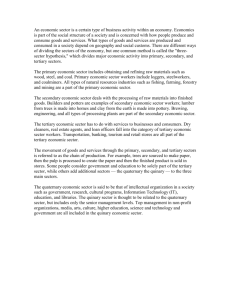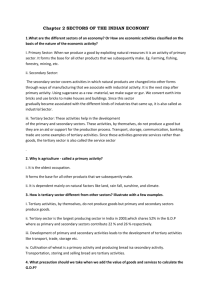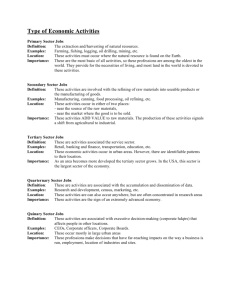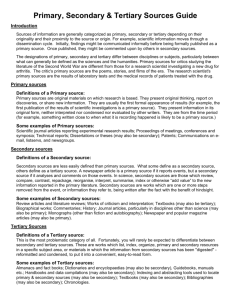Document
advertisement
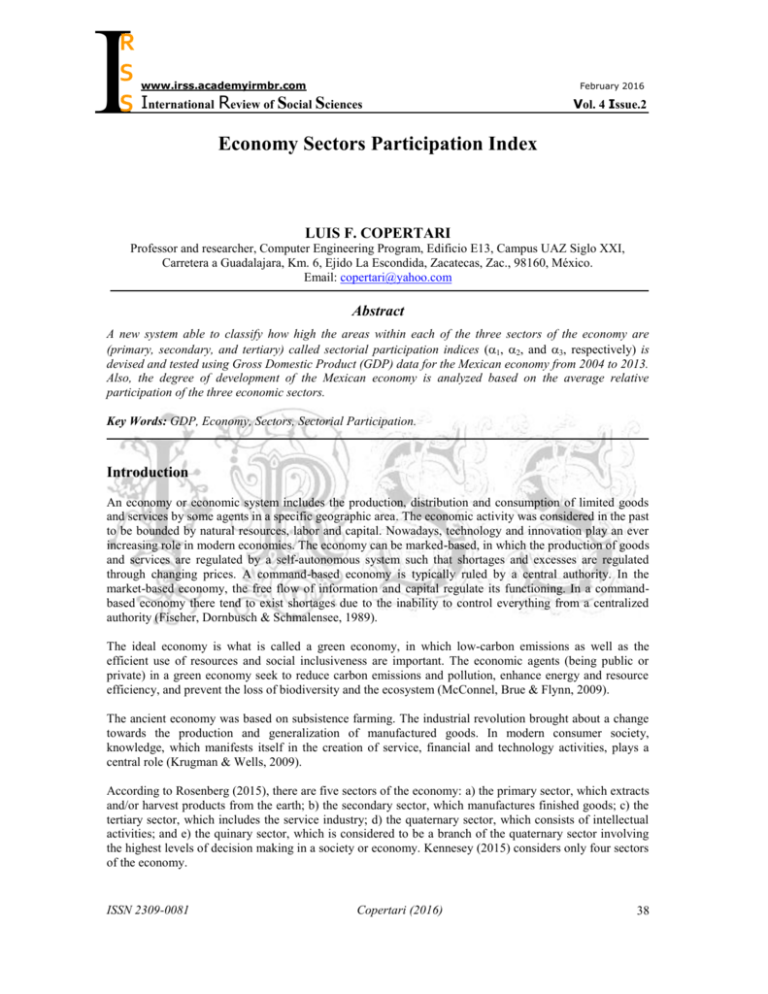
I R S www.irss.academyirmbr.com S International Review of Social Sciences February 2016 Vol. 4 Issue.2 Economy Sectors Participation Index LUIS F. COPERTARI Professor and researcher, Computer Engineering Program, Edificio E13, Campus UAZ Siglo XXI, Carretera a Guadalajara, Km. 6, Ejido La Escondida, Zacatecas, Zac., 98160, México. Email: copertari@yahoo.com Abstract A new system able to classify how high the areas within each of the three sectors of the economy are (primary, secondary, and tertiary) called sectorial participation indices (1, 2, and 3, respectively) is devised and tested using Gross Domestic Product (GDP) data for the Mexican economy from 2004 to 2013. Also, the degree of development of the Mexican economy is analyzed based on the average relative participation of the three economic sectors. Key Words: GDP, Economy, Sectors, Sectorial Participation. Introduction An economy or economic system includes the production, distribution and consumption of limited goods and services by some agents in a specific geographic area. The economic activity was considered in the past to be bounded by natural resources, labor and capital. Nowadays, technology and innovation play an ever increasing role in modern economies. The economy can be marked-based, in which the production of goods and services are regulated by a self-autonomous system such that shortages and excesses are regulated through changing prices. A command-based economy is typically ruled by a central authority. In the market-based economy, the free flow of information and capital regulate its functioning. In a commandbased economy there tend to exist shortages due to the inability to control everything from a centralized authority (Fischer, Dornbusch & Schmalensee, 1989). The ideal economy is what is called a green economy, in which low-carbon emissions as well as the efficient use of resources and social inclusiveness are important. The economic agents (being public or private) in a green economy seek to reduce carbon emissions and pollution, enhance energy and resource efficiency, and prevent the loss of biodiversity and the ecosystem (McConnel, Brue & Flynn, 2009). The ancient economy was based on subsistence farming. The industrial revolution brought about a change towards the production and generalization of manufactured goods. In modern consumer society, knowledge, which manifests itself in the creation of service, financial and technology activities, plays a central role (Krugman & Wells, 2009). According to Rosenberg (2015), there are five sectors of the economy: a) the primary sector, which extracts and/or harvest products from the earth; b) the secondary sector, which manufactures finished goods; c) the tertiary sector, which includes the service industry; d) the quaternary sector, which consists of intellectual activities; and e) the quinary sector, which is considered to be a branch of the quaternary sector involving the highest levels of decision making in a society or economy. Kennesey (2015) considers only four sectors of the economy. ISSN 2309-0081 Copertari (2016) 38 I R S www.irss.academyirmbr.com S International Review of Social Sciences February 2016 Vol. 4 Issue.2 Nevertheless, for the purposes of this paper, only a three-sector economy is being considered as discussed by Fisher (1939). In this economy, there is the extraction of raw materials (primary sector), manufacturing (secondary sector), and services (tertiary sector). Theory Considering an economy with three sectors, let be the total value (in millions of pesos) of sector i, where i=1 is primary sector, i=2 is secondary sector, and i=3 is tertiary sector and t is the year when the Gross Domestic Product (GDP) for such sector is being measured. Also, let a, b and c, be the total number of areas in the primary, secondary and tertiary sectors, respectively. Also, let be the value (in millions of pesos) of area k for sector i, where k = 1,…,a, k = 1,…,b, and k = 1,…,c, for sectors i=1, 2, and 3 (primary, secondary and tertiary), respectively, having t as the year when the measurement is taken. The coefficient ( for time t) associated with area k within sector i measures how close to the highest value in such sector the area is. Finally, is the participation index of sector i (primary, secondary and tertiary) for time t. Clearly, the sum of all the areas k within sector i for time t ( ) equals the total GDP measurement made for sector i and time t ( ). The latter is depicted in equation (1). Equation (2) indicates how the participation index for sector i ( ) and the relevance index for area k within sector i ( ) for any given time t are related with the GDP measurements for area k and sector i. i = 1, 2, and 3; and year t i = 1, 2, and 3; and year t (1) (2) From equation (2) results equation (3), which measures the participation index of sector i. i = 1, 2, and 3; and year t (3) Finally, the relevance index is given according to equation (4). Notice that goes from zero (the lowest GDP value) to one (the highest GDP value) for any given area k within sector i. Thus, the participation index ( ) indicates how close to the highest GDP value the areas k within sector i are. (4) Testing In order to test the theory, data from INEGI’s “Banco de Information Económica” or Economic Information Database (2015) was obtained for the GDP of the three sectors of the Mexican economy and their corresponding areas within each sector from years t = 2004 to t = 2013. Figure 1 illustrates the behavior of the primary sector, Figure 2 the behavior of the secondary sector, and Figure 3 the behavior of the tertiary sector. ISSN 2309-0081 Copertari (2016) 39 I R S www.irss.academyirmbr.com S International Review of Social Sciences February 2016 Vol. 4 Issue.2 Figure 1. GDP for the primary sector from 2004 to 2013. Figure 2. GDP for the secondary sector from 2004 to 2013. Notice that a equals 1 since there is only one area in the primary sector, b equals 15 since there are fifteen areas in the secondary sector and c equals 14 given the fact that there are fourteen areas in the tertiary sector. The actual data takes too much space to be displayed in a table, and thus the graphical representation of such data is chosen. ISSN 2309-0081 Copertari (2016) 40 I R S www.irss.academyirmbr.com S International Review of Social Sciences February 2016 Vol. 4 Issue.2 Figure 3. GDP for the tertiary sector from 2004 to 2013. Results Figure 4. Average share of the three sectors in the Mexican economy. In order to position the type of economy Mexico has, the average of the GDP value of each sector (primary, secondary and tertiary) was taken for all 10 years (from 2004 to 2013) and their respective percentages plotted, which is shown in Figure 4. ISSN 2309-0081 Copertari (2016) 41 I R S www.irss.academyirmbr.com S International Review of Social Sciences February 2016 Vol. 4 Issue.2 Table 1. Participation indices (’s) for the primary, secondary, and tertiary sectors as time goes by. Year Primary Sector Secondary Sector Tertiary Sector (Unindustrialized) (Manufacturing) (Services) 2004 100.00% 58.68% 54.37% 2005 100.00% 61.56% 53.39% 2006 100.00% 61.73% 53.04% 2007 100.00% 62.72% 52.66% 2008 100.00% 62.82% 52.46% 2009 100.00% 57.40% 54.67% 2010 100.00% 61.95% 53.38% 2011 100.00% 60.80% 52.16% 2012 100.00% 63.00% 51.69% 2013 100.00% 65.40% 51.39% Figure 5. Participation indices (’s) for the primary, secondary, and tertiary sectors as time goes by. Also, based on the system of equations from (1) to (4) the participation index of each sector was calculated. Table 1 summarizes the results and Figure 5 illustrates them. Discussion and Conclusion The first to notice is the relative importance of the three sectors of the Mexican economy. In a tertiary civilization the workforce among the sectors of the economy are 10%, 20%, and 70% for the primary, secondary, and tertiary sectors (Mankiw, 2012). Although in this paper the workforce of each sector is not measured but rather the GDP of each sector, it can nevertheless be said that the GDP percentages from Figure 4 correspond more closely to a tertiary civilization. In this case, the primary and secondary sectors are increasingly dominated by automation, and the workforce demand in these sectors falls. It is replaced by growing demands in the tertiary sector. This situation corresponds to a modern-day industrial society and even the society of the future, called the service or post-industrial society. In this case even a quaternary sector (information-based) and a quinary sector (human services based) are created to analyze the dominating tertiary sector. It seems interesting that given the results obtained, INEGI is still using the old-fashioned three-sector theory for its statistics as indicated in the “ABC Sistema de Cuentas Nacionales de México” or ABC Mexico’s National Accounting System (INEGI, 2015). ISSN 2309-0081 Copertari (2016) 42 I R S www.irss.academyirmbr.com S International Review of Social Sciences February 2016 Vol. 4 Issue.2 Also notice the results obtained for the participation indices. In the case of the primary sector, the participation index (1) was always 100% because there is only one area considered in this sector. However, the participation indices of the secondary and tertiary sectors (2 and 3, respectively) do provide useful information. First of all, notice that in Figure 5, the secondary sector participation index (2) is always higher than the tertiary sector participation index (3). This reveals that although as it was previously speculated the Mexican economy appears to be a post-industrial society, it seems not quite that the case given the fact that the participation index for the secondary sector is always higher than the participation index of the tertiary sector, which indicates that the secondary and not the tertiary sector is more developed. Consequently, the participation index does provide useful information. Also, notice the historical behavior of the participation indices for the secondary and tertiary sectors (the only exception is between 2010 and 2011, when both indices dropped). When the participation index for the secondary sector rises, the participation index for the tertiary sector falls, and viceversa. Apparently, the internal composition of these two sectors shows a paradox. The latter seems to imply that there is a dependency between the internal compositions of the areas within the secondary sector with respect to the tertiary sector. In conclusion, although the Mexican economy may appear to be in a post-industrial age, the sectorial participation index analysis reveals that it is not there quite yet. References Fischer, S., Dornbusch, R. & Schmalensee, R. (1989). Economía. México, D.F.: McGraw-Hill. Fisher, A. (1939). “Production, primary, secondary and tertiary”, Economic Record, 15(1), 24-38. Inegi. (2015). ABC Sistema de Cuentas Nacionales de México: Cuentas por Sectores Institucionales. Retrieved from: http://www.inegi.org.mx/est/contenidos/espanol/metodologias/cuentas/anuales/abc_cuentas.pdf. Inegi. (2015). Banco de Información Económica. Retrieved from: http://www.inegi.org.mx/sistemas/bie/?idserPadre=102000520020006000950060. Kennesey, Z. (2015). The Primary, Secondary, Tertiary and Quaternary Sectors of the Economy. Retrieved from: http://www.roiw.org/1987/359.pdf. Krugman, P. & Wells, R. (2009). Economics. New York, NY: Worth Publishers. Mankiw, N. G. (2012). Principles of Economics. Mason, OH: South-Western Cengage Learning. McConnel, C. R., Brue, S. L. & Flynn, S. M. (2009). Economics: Principles, Problems, and Policies. New York, NY: McGraw-Hill. Rosenberg, M. (2015). Sectors of the Economy. Retrieved from: http://geography.about.com/od/urbaneconomicgeography/a/sectorseconomy.htm. ISSN 2309-0081 Copertari (2016) 43

